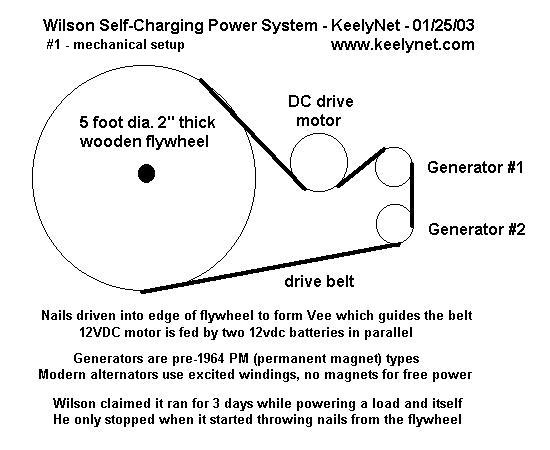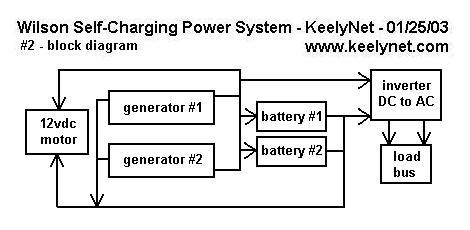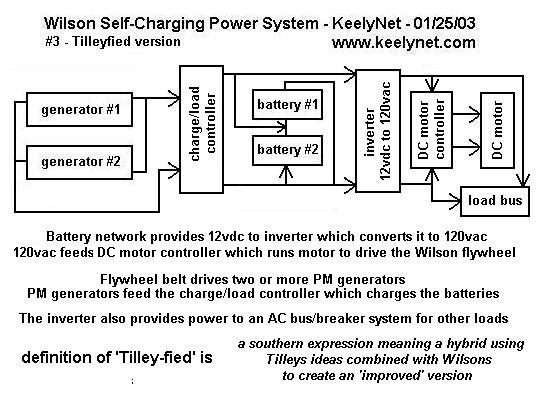(6 of 7) - The Wilson Machine
by Jerry Decker for KeelyNetIn mulling over the Tilley claims over the past few months, what we saw, what my pictures show and what I've read on the web, I remembered something that happened in Texas several years ago that I think relates to both Tilley and Bedinis' Gravity Field Generator. A friend called me to say I should check out the local paper for an article about an old fellow named Wilson who lives somewhere out in East Texas...I got the paper and was intrigued by the short story because Mr. Wilson claimed to have a big flywheel some 5 feet in diameter and about 2 inches thick. This thing was powered by a DC motor and also ran 2 or more generators which charged a battery network and he claimed this system was self-running... Well, that got my interest so I tracked down his number and called him...he very kindly invited me out to see his setup....I was working nights but managed to take off for a weekend and drove roughly 150 miles way out in the boonies until I found his house. When Mr. Wilson was still working (he was I think around 80 years old at that time), he used to run a greenhouse and farmed so he still had some big buildings on his country property....his wife was a sweet little lady who offered us cold lemonade as it was a hot day... Mr. Wilson took me to a prefab building roughly 20 X 40 with a middle aged black fellow who worked for him as handyman around the house....they had known each other a long time and were pretty close....he said it really did run by itself as he'd seen it tested and had helped Mr. Wilson build it and maintain it. The machine had a big wooden flywheel made out of a wooden tabletop like you can buy at Home Depot. This flywheel was about 5 feet in diameter and 2 inches thick. He had nails driven all around the rim to form Vees like a V-Belt pulley...this was to hold the long belt onto the flywheel.

He had 2 generators with a tensioning roller for the belt and I think it was a DC motor that drove it. All this was connected by a long belt held onto the wooden flywheel by the nails forming a V all around the rim. The output from the generators was fed to the batteries, the batteries provided power to the motor and he had a small bank of light bulbs hooked up to it as a load. He cranked it up and it spun, very wobbly and unstable as it was definitely redneck construction...but charming in its way...Mr. Wilson said after running for long periods or if the speed got too high, the nails would come 'a-flying' out and cause him to shutdown the wheel... I asked him the longest he'd ever run it non-stop and he said for 3 days but the nails started a-flying and he had to shut it down....

I stayed there all day, just delighted to hear him talk and show me the various parts of the machine...he used several clip on ammeter gauges at various parts to show the current flowing. He had several of these gauges placed on various wires from the battery to the motor, from the generators, from the batteries to the load, etc. and there did seem to be more current flowing into the batteries from the generator than the DC motor was using to spin the wooden flywheel, unfortunately I don't recall the numbers as it was some 10-12 years ago. I asked Mr. Wilson what he intended to do with this, was it for sale, did he want to patent and/or license it, did he want to give it away?? He said he just wanted to help the world, it was not patented nor had anyone else independently proven it. At the end of the day, I had to drive back to Dallas so he said he was going to tell me the secret. Mr. Wilson said modern generators/alternators would not work in such a system. He said the flywheel helped to store 'extra' energy and that in modern alternators they used excited windings, meaning you have to use current from the batteries to create the magnetic field that is cut to produce current to run the car and recharge the batteries....he said because of this, it could NEVER produce more out than in because it was wasting current keeping the excited windings alive... Mr. Wilson said only generators from vehicles 1964 and BEFORE had PM (permanent magnets) in them so that simply spinning them produced power....he said he had put in more than 2 generators and generated even more power so that his machine could be scaled up as necessary for greater power production, in other words, it was 'scaleable'. The bulbs I saw were fed from an inverter connected to the batteries, there were ONLY 2 BATTERIES in parallel in this arrangement as I recall. Accordingly, Mr. Wilsons machine seems quite similar to Bedinis' though on a larger, redneck scale. Mr. Wilson said it is the PM magnet generators that do the trick. His generators were taken from old cars in an auto junkyard and unmodified as was the motor. Everything off the shelf, no tricks, no pulses, no back emf, just that old wobbly flywheel with the nails for the V-belt. Mr. Wilson might still be alive today, its been about 10-12 years ago when I went to visit him....very nice fellow as was his wife....typical of native Texans, friendly, outgoing, would give you the shirt off their back if you needed it....a pleasure and an honor to have had the privilege to meet him for that one day... An email sent in on this subject by Emmett says, "The pre 64 "alternators were called generators and even though they contain no permanent magnets, they do not require the field to be excited by voltage, they only need to be polarized in order to get them to charge the right way I.E. plus to minus can go either way. In my experience, I have found most alternative energy researchers can't help but try to improve on things, a definite NO-NO with overunity devices where the original MUST be left untampered with. It is safer and smarter to try building another one and see if the effect can be duplicated, but NEVER mess with the original. I understand this is one of the problems with the Lutec 1000 claim of a self-running magnetic generator. The duplicate generator 'only works when they used parts from the original.' A 'lab-queen' by any other name. I thought it would be interesting to apply some of Tilleys off the shelf units to the Wilson system to make a 'Tilley-fied version' and this is the block diagram.

To get an idea of how long a 12vdc battery will supply a load, we can use;Ampere load X Duration time = Ampere Hours A battery that would deliver 2 Amperes for 20 hours would have a 40-amp hour battery rating (2 amps X 20 hours = 40 amp hours). Another example, a 100 amp hour battery with a 20 hour discharge rate is designed to deliver 5 amps. Every hour it will deliver 5 amp hours and in 20 hours it will have delivered 100 amp hours (if it could be completely drained). If the battery is discharged faster, its capacity will be LESS and if it is discharged slower, its capacity will be GREATER. If this same 100 amp hour battery was discharged at 20 amps instead of 5 amps, its capacity would drop to only 60 amp hours. So, at a 5 hour discharge rate, our 100 amp hour battery becomes a 60 amp hour battery. A 100 amp battery will supply 5 amps for 20 hours, but will NOT supply 10 amps for 10 hours, a kind of discharge reciprocity effect (called the Peukert Effect) based on how fast you pull current from the battery. A 60 Watt light bulb on a 12 volt system draws about 5 amps (12vdc X 5 amps = 60 Watts). Another example, if you had a 60 watt load you ran for 10 hours each day for 3 days you would consume 1800 watt-hours (10 hours/day X 60 watts X 3 days = 1800 watt-hours). Since voltage X amperage = watts, then 1800 watt-hours / 12 volts = 150 amp-hours, the rating for the battery you need. If you take five 6 volt 10AH batteries and connect the batteries in SERIES, you would end up with a battery ARRAY that is 30 volts and 10AH. If you connect the batteries in parallel, you would end up with a battery array that is 6 volts and 50AH. Ordinary auto batteries are made by connecting batteries in series. Six 2 volt cells are put in series to give a 12vdc battery and the 6 cells are just enclosed in one case.Some examples of loads and their ratings taken from an RV (recreational vehicle) site; 
For AC Appliances
AC Appliance
Current Consumption
Daily Use
Total Daily Consumption
TV set 5 amp-hour 6.0 hours 30.0 amp-hour Microwave 85 amp-hour 0.1 hours 8.5 amp-hour Hair dryer 125 amp-hour 0.1 hours 12.5 amp-hour VCR 3 amp-hour 3.0 hours 9.0 amp-hour 120 volt light 1 amp-hour 3.0 hours 3.0 amp-hour Blender 3 amp-hour 0.1 hours 0.3 amp-hour Toaster 90 amp-hour 0.1 hours 9.0 amp-hour Total AC appliance usage = 76.3 amp-hour as measured at the 12vdc input to an inverter.
Taking into consideration a 50 percent safety margin, you would need at least 221.2 amp-hours worth of batteries.
For DC Appliances;
DC Appliance
Current Consumption
Daily Use
Total Daily Consumption
Refrigerator 0.25 amp-hour 18.0 hours 4.5 amp-hour Propane Alarm 0.35 amp-hour 24.0 hours 8.4 amp-hour Water pump 4.00 amp-hour 0.2 hours 0.8 amp-hour Cassette Player 2.00 amp-hour 4.0 hours 8.0 amp-hour Porch light 1.80 amp-hour 3.0 hours 5.4 amp-hour Interior light 1.80 amp-hour 4.0 hours 7.2 amp-hour Total DC Appliance usage = 34.3 amp-hour Total Battery usage = 76.3 (for AC appliances above) + 34.3 (for DC) = 110.6 amp-hour
The Wilson machine used two 12vdc auto batteries in parallel, but I have no idea of their amp-hour ratings. To estimate, lets try 200 amp-hours per battery. Using the Parallel connection guide above, two 12vdc batteries would yield 12vdc at 400 amp-hours. That means if we hooked up ten 100 Watt light bulbs as our load, each bulb using 1 amp at 100 volts = 100 Watts, then it would pull 1,000 Watts or 10 amps per hour. So a dual battery parallel setup rated at 400 amp-hours would last about 40 hours (10 amps X 40 hours = 400 amp-hours), before discharging. Remember, Mr. Wilson said it ran for 3 days which is 72 hours, meaning if his story is true and it ran the full 3 days, he almost doubled the 40 hour normal run-time. 
I want to point out the use of a heavy rotating mass (flywheel) as used in both the Bedini and Wilson machines, both of which claimed overunity, Bedini on the order of an efficiency rating of 800%. There could be a connection here between inertial damping/acceleration (as with uni-directional drives that 'jerk' themselves in a preferred direction) and coupling with gravity to extract additional energy from the ambient gravity field. This would lead us to an additional piece of information about what is in Tilley's spinner box which will be brought up in the next and WHEW!, the LAST page in this series. 
We can also apply this information to the Tilley systems, both building and electric vehicle. We made no actual measurements but the batteries in the car were the same as in the building power supply except that they used twelve 12vdc Series batteries in the car whereas the building system used 8 parallel batteries. WalMart off-the-shelf FLEET brand, Model 31-5T, with cranking amps 1190 and cold cranking amps of 1000. The closest to a conversion formula for cold cranking amps vs amp-hours is;  AMP-HOUR battery rating : calculated by multiplying the current (in amperes) by time (in hours) that the current is drawn.For the Tilley Building Power System;
AMP-HOUR battery rating : calculated by multiplying the current (in amperes) by time (in hours) that the current is drawn.For the Tilley Building Power System;To determine Cold Cranking Amps (CCA) from Amp-Hour rating, COLD CRANKING amperage battery rating : CCA is the discharge load in amps which a battery can sustain at 0 degrees F. and not fall below 1.2 volts per cell (7.2v on a 12v battery). This rating measures a burst of energy that a car needs to start on a cold morning.
multiply the Amp-Hour rating by 6.To determine Amp-Hour rating from Cold Cranking Amps (CCA), Therefore, the Fleet battery rated with a CCA of 1000 amps, would be 1000 amps / 6 = 167 amp-hours per battery.
divide cold cranking amps by 6.The meter showed 18 amps at 13 volts which is 234 watts. 8 batteries at 167 amp-hours each would be 12vdc at 1336 amp-hours. 1336 amp-hours / 18 amps = 74.2 hours before the batteries should run down, a bit over 3 days.For the Tilley Electric Vehicle system;12 batteries at 167 amp-hours each and in SERIES is 144vdc at 167 amp-hours or 144vdc X 167 amps = 24,048 watts maximum. The FB1-4000 - 85hp peak motor uses 90-144vdc at 190 amps continuous. Worse case full throttle is 144vdc X 190 amps = 27,360 watts. Since one HP = 760 Watts, then 85HP X 760Watts = 64,600 Watts. As you can see it doesn't add up unless the true battery amp-hour rating is 449 amp-hours, where 64,600watts / 144vdc = 449 amps 64,600W - 24,048W = 40,552 watts more than what the system can produce. Charge/discharge rates play a part and he won't be running his electric vehicles for sustained periods at full throttle. After all it is to my view a much more DYNAMIC system, being in motion, than the building power supply system. Lots of room for errors in calculation here and I'm open to correction.
1) - The Trip |
4) - Block diagrams w/parts listings |
2) - The Tilley Building Power System |
5) - Bedini Gravity Field Generator |
3) - The Tilley Electric Vehicle |
6) - The Wilson Machine |
7) - The Manta Generator |
If you found this file useful or interesting, please consider a donation or a purchase to help keep KeelyNet online and providing free information. Thanks! |